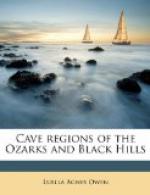“As the author has asked me for an article descriptive of the cave, I will only attempt to say something of our medium length route to the Fair Grounds, or in other words, the Fair Grounds’ Route. A collective description of the whole cave would take months—even years—to complete. Besides, the above route is the one most used by visitors at the present time.
“On entering the Cave House (a log structure) you will in all probability ask from whence comes the murmur of a waterfall. The guide answers that it is the rushing current of air at the mouth of the cave, sometimes in and sometimes out. Prof. J.E. Todd, in bulletin No. 1, S. Dakota Geological Survey, p. 48, says: ’This phenomenon is found to correspond with the varying pressure of the barometer, and with its single opening and capacious chambers is easily accounted for.’
“The rushing air is sometimes strong enough to require a man’s weight to open the entrance door. Five days and nights is the longest time the wind has been known to move in one direction without ceasing. This is one of nature’s greatest atmospherical phenomena.
“Some one says, ‘Tickets, please!’ and into the hole we go, single file down a lighted passageway to where we can light our candles. After descending about one hundred and fifty-five feet we come into the Bridal Chamber (named by some of the earlier explorers before the present management took hold of the property), which is eight or ten feet in length by twenty feet in breadth. Passing along some distance, the Snow-ball Room is entered. It carries this name on account of little rosettes of carbonate of lime sticking to the irregular ceiling. This room is pretty narrow and some fifty feet in length.
“The Post Office is next and soon reached. The ceiling is covered with the box work formation somewhat resembling Post Office boxes. You will no doubt wonder why it carries such a common name.
“Just because after searching in what books on geology and other sciences we could get, we could not find it described nor any formation resembling it; hence its common name, as we have named the pop-corn work, frost work etc., from their appearance.
“The dimensions of the Post Office are some eighty feet in length by twenty feet in width, with an average ceiling height of probably twelve feet. Red Hall is the room next in order, and has on either side a red bank of sandy, micaceous clay.
“Just to the left is a very pretty little grotto of box work. This room is very odd in make-up. The floor is very rough and dips about fifteen feet in its length of sixty feet, and includes a short flight of stairs. The lowest end of the room is prettily decorated, and some pleasing blends of color attract the eye. To the left is the Old Maids’ Grotto, a pretty little nook that would please any maid old or young.
“After passing through the White Room we turn to the left along the crevice, and after traveling some little distance reach The Grand Opera, a very narrow room but some forty feet in length. Chopin’s Nocturne is a small grotto in the right hand wall named by the famous violinist, Edouard Remenji.




